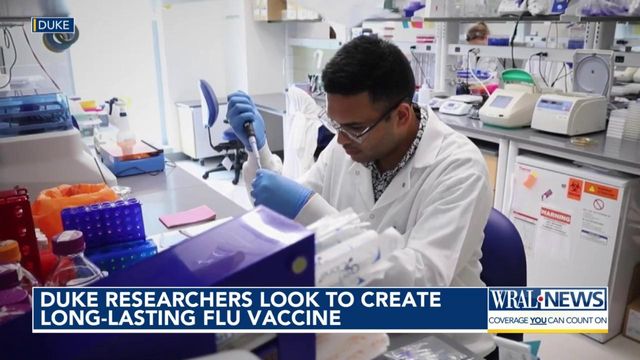Fewer flu shots: Duke researchers working toward a vaccine that could last for years
Duke University researchers are continuing their efforts to create a better, longer-lasting flu vaccine.
New research announced Wednesday in the journal Science Translational Medicine looked at hemagglutinin. It’s the protein that allows the flu virus to attach to a human cell and make a person sick.
Scientists created an experimental vaccine that encouraged the immune system to target different areas of the flu virus to help fight infection.
“In essence what we are trying to do is figure out a way to get our immune systems to see parts of the virus that the virus doesn’t want us to see,” explained Nicholas Heaton, Ph.D.
Heaton is the study lead. He currently works as an associate professor of molecular genetics and microbiology at Duke.
He explained creating a vaccine that targeted parts of the flu virus that vary less between strains could potentially offer broader protection for different kinds of flu within the same shot.
“The approach that we took was to make a really complex mixture of virus proteins where essentially all these epitopes are kind of scrambled to make the immune system have a better chance of seeing parts of the protein they wouldn’t normally see,” said Heaton.
Current annual flu shots offer protection for roughly six months due to mutations in the virus and varying strains that circulate each flu season. Scientists predict a universal flu vaccine could increase protection by a few years form a single shot.
The new study showed the experimental vaccine was more effective than traditional flu vaccines when given to mice.
Mice were tested in three groups: those given the experimental vaccine, those given a traditional flu shot and a control group.
They were then given lethal doses of two kinds of flu virus. One strain was what the traditional flu shot was tailored directly to fight and the second strain was of a mutation to the virus.
The mice that were given the experimental vaccine had the highest level of protection in both scenarios, losing a very small amount of body weight and surviving, compared to the other two groups.
Heaton said the results are encouraging but notes there is a long way to go before the research develops into a dose regularly used in humans.
“It’s tempered enthusiasm to some extent,” he explained. “We have something that – out of all the ideas we tested – this one is looking really good and really promising.”
When asked how long he thought it could be until the research turned into a human vaccine, Heaton hypothesized it could take another decade.
“I think this will probably ultimately manifest as a couple different shots for different age groups. There will probably be a couple different shots for babies that do a good job, for adults, for the elderly,” said Heaton. “You may need to get it once every five years, once every ten years. I would say those type of things are much more reasonable goals.”
Heaton says the next step for this study is to continue testing the vaccine against multiple other flu strains in mice to see if the doses continue to be effective.











